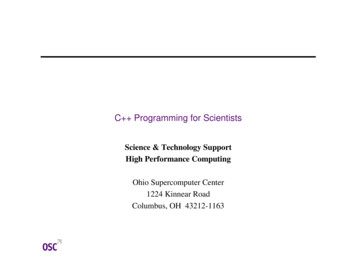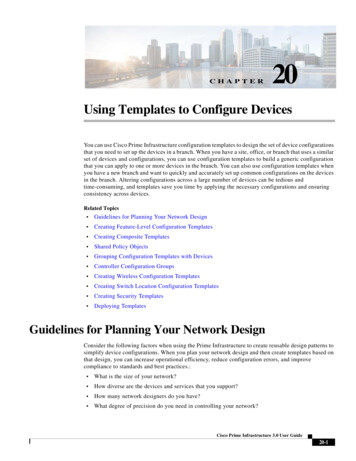
Transcription
Body-part templates for recovery of 2D humanposes under occlusionRonald Poppe and Mannes Poel?Human Media Interaction Group, Dept. of Computer Science, University of TwenteP.O. Box 217, 7500 AE, Enschede, The Netherlands{poppe,mpoel}@ewi.utwente.nlAbstract. Detection of humans and estimation of their 2D poses froma single image are challenging tasks. This is especially true when partof the observation is occluded. However, given a limited class of movements, poses can be recovered given the visible body-parts. To this end,we propose a novel template representation where the body is dividedinto five body-parts. Given a match, we not only estimate the joints inthe body-part, but all joints in the body. Quantitative evaluation on aHumanEva walking sequence shows mean 2D errors of approximately27.5 pixels. For simulated occlusion of the head and arms, similar resultsare obtained while occlusion of the legs increases this error by 6 pixels.1IntroductionDetection and analysis of humans in images and video has received much research attention. Much of this work has focussed on improving pose estimationaccuracy, while partly ignoring the difficult localization task. Despite increasedawareness, the two processes are still researched in relative isolation, inhibitinguse in realistic scenarios. Another issue with the current state of the art is thesensitivity to cluttered environments and, in particular, partial occlusions.In this paper, we aim at simultaneous human detection and 2D pose recovery from monocular images in the presence of occlusions. We do not model thebackground, thus allowing our algorithm to work in cluttered and dynamical environments. Moreover, we do not rely on motion, which makes this work suitablefor estimation from a single image. The output of our approach can be used asinput for a more accurate pose estimation algorithm.Our contribution is a novel template representation that is a compromise between half-limb locators and full-body templates. We observe that, for a limitedclass of movements, there is a strong dependency of the location of body-parts.For example, given a walking motion, we can accurately predict the location ofthe left foot while observing only the right leg. To this end, we divide the humanbody into five body-parts (arms, legs and torso), each of which has associated?This work was supported by the European IST Programme Project FP6-033812(publication AMIDA-105), and is part of the ICIS program. ICIS is sponsored bythe Dutch government under contract BSIK03024.
2edge and appearance templates. Given a match of body-part template and image, we not only vote for the locations of joints within the body-part but for alljoint locations. This approach allows us to recover the location of joints that areoccluded (see Figure 1). We first apply the templates over different scales andtranslations, which results in a number of estimations for each 2D joint location.In a second step, we approximate the final joint locations from these estimations.In this paper, we focus on the matching, and keep the estimation part trivial.Fig. 1. Conceptual overview of our method. Templates from different exemplars andbody-parts match with part of the image. Joint estimates are combined into a poseestimate. Anchor points are omitted for clarity. Occlusion of the right arm is simulated.We first discuss related work on human pose recovery. The two steps of ourapproach, template matching and pose estimation, are discussed in Section 3and 4, respectively. We present quantitative results on the HumanEva data setin Section 5, both on original image sequences and with simulated occlusion.2Related work on monocular pose recoveryHuman motion analysis has received much attention [1]. Here, we focus onmonocular approaches that can deal with cluttered, dynamic environments andocclusion. In general, we can distinguish two main classes of approach.Discriminative approaches learn a mapping from image to human pose, wherethe image’s region of interest is conveniently encoded in an image descriptor.Such approaches focus on poses that are probable, which is a subset of all physically feasible ones. Shakhnarovich et al. use histograms of directed edges and anefficient form of hashing to find similar upper-body examples from a database[2]. Agarwal and Triggs learn regression functions from extracted silhouettes tothe pose space [3]. These approaches are efficient, but require accurate localization of the human from the image. Also, they are sensitive to noise in the regionof interest, due to incorrect localization or segmentation, and occlusions. Someof these drawbacks have been partially overcome. Agarwal and Triggs suppressbackground edges by learning human-like edges [4], thus alleviating the need for
3good segmentation. Howe uses boundary fragment matching to match partialshapes [5]. His approach requires that background and foreground are labelled,which limits its applicability to domains where such a segmentation is available.The second class is that of generative approaches. These use a human bodymodel that describes both the visual and kinematic properties of the humanbody. Pose estimation essentially becomes the process of finding the parametersthat minimize the matching error of the visual model with the image observation.The direction of estimation is either top-down or bottom-up.In top-down estimation, a projection of the human body is matched withthe image observation, and usually improved iteratively. The process is hinderedwhen occlusion occurs, since no image observation is present for the occludedpart of the body. This can lead to unrealistic poses. A practical problem is thehigh dimensionality of the parameter space, which makes initialization difficult.A recent trend to overcome this problem is to use dimensionality reduction inthe kinematic space, which can be regarded as a strong prior on the poses thatcan be observed. This reduction is motivated by the observation that there is astrong correlation in the movement of different body-parts, especially within asingle movement class such as walking.In bottom-up estimation, individual body-parts are found first and then assembled into a human body. In general, weak half-limb detectors are used, whichresults in many false positives. Many of the bottom-up works resemble the pictorial structures idea, which was applied to human pose recovery by Felzenszwalband Huttenlocher [6]. The key idea is to model the appearance of each bodypart individually, and represent the deformable assembly of parts by spring-likeconnections between pairs of parts. Most of this work relies on inference in a treelike structure [6–8]. Again, there are two major drawbacks with the bottom-upapproach. First, the templates are usually at the level of half-limbs (e.g. upperleg) which results in many false positives. Second, the 2D location of a templatedoes not give any information about the rotation in 3D. This makes it difficultto enforce 3D constraints, such as joint limits, on the relative position betweentwo adjacent parts. Such constraints are needed to be able to recover realisticposes when part of the body in the image is occluded.In this paper, we propose an approach that combines several of the ideasabove, while it aims at circumventing the major drawbacks. First, we use bodypart templates that encode exactly one body-part (arm, leg or torso). Such arepresentation is more meaningful than that of half-limbs, and reduces falsepositives since the templates implicitly encode the view. Second, by voting overall joints, we can cope with occlusions and recover the pose even when onlypart of the human body is visible. See also Figure 1. Our work resembles thatof Demirdjian and Urtasun [9], who vote over the pose space using patchesthat are similar to those in the image. Patches and their joint location densitiesare learned from a large annotated database. Our work differs since our fewtemplates can be generated automatically using 3D modelling software. We focuson walking movements only. This effectively puts a strong prior on the poses thatwe can recover, which is a limitation of our work.
43Template matchingWe introduce full-body templates that consist of five, possibly overlapping, bodypart templates, see Figure 2. We will call a full-body template exemplar. For theestimation of articulated poses, we use a collection E of n exemplars Ei E (1 i n). Each exemplar consists of a tuple that describes the 2D pose u and thebody parts p, Ei (u, p). Note that we do not include information about the3D orientation and scaling since this is implicitly encoded in the templates and2D pose. For clarification of notation, subscripts are omitted where possible.(a)(b)(c)(d)Fig. 2. (a) Exemplar with all color regions, (b) color regions and (c) edge template ofleft arm, (d) 2D joint locations (body shown for reference). Closed dots are used in theevaluation, see Section 5. The anchor point is the left-upper corner of the box.Each element in u is a 2D joint location written as a tuple ui (xi , yi ) u (1 i m). These locations are relative to the anchor point, which is bydefault the left upper corner of the minimum enclosing box of all templates. Inprinciple, we use m 20 joints, as shown in Figure 2(d).Each pi p (1 i 5) represents exactly one body-part (leg, arm ortorso). We can write it as a tuple pi (t, r). Here, t is an edge template, whereeach element ti (xi , yi ) t (1 i t ) represents an edge pixel at a givenlocation, relative to the anchor point. t is the number of elements in t. Eachbody-part has several color regions, each of which is assumed to have a constantcolor. The number of regions per body-part, r , is three for each leg and arm,and five for the torso (see also Figure 2(a-b)). Similar to our edge representation,each region ri (1 i r ) consists of a number of relative pixel locations, whichcan be considered the foreground mask. The total number of foreground pixelsin a region is denoted with ri for the ith region.
5In summary, each exemplar consists of five body-parts, each of which represents a limb or the torso. Each body-part has an associated edge template,and a number of color regions. Templates and 2D joint locations are positionedrelative to the anchor point.3.1Template distanceFor the matching, the notion of an exemplar is not needed, rather that of thebody-parts individually. The match of a body-part and an image region is determined by calculating the distance of the edge and color templates individually.For the edge matching, distance transforms such as the Chamfer distance arecommon. For such a transform, both image and template need to be convertedto a binary edge map. The distance transform gives the (approximate) distanceto the nearest edge pixel. The matching score is calculated by summing alldistance transform values in the image “under” the edge pixels. One problemthat we found while using this technique is that is favors areas that are denselycovered with edges. Also, the performance proved to be very sensitive to thevalue of the edge magnitude threshold. Therefore, we use the edge magnitudesof the image directly, by calculating the derivative Iedge of the image in grayscale. Distance score edge for template tj with the anchor at location (sx, sy)is given by:XIedge (sx x, sy y) edge (Iedge , tj , sx, sy) (x,y) tj tj (1)To evaluate the distance of the color template, we determine the color deviationscore color for each region rk at anchor point (sx, sy):X X Icolor (sx x, sy y, ci ) µ color (Icolor , rk , c, sx, sy) ci c (x,y) rk c rk (2)Here, Icolor is the color image, c is a vector with c color channels. We make noassumptions about the color space of the image. µ is the shorthand notation forµ(Icolor , rk , ci , sx, sy), the mean value of all “region” pixels in the color channelwhen no appearance assumptions are made. Alternatively, if the region colorsare set beforehand, µ corresponds to a(j, k, i) the specified value for body-partj, region k and channel i. Alternatively, we could have used color histograms, asin [8] but it seems unrealistic that these can be determined beforehand.The distance for all color regions together is the sum of the means of eachregion, weighted on the size of the regions rk . We have distances rather thanprobabilities, so we need to determine when a match occurs. Therefore, we introduce thresholds η and θ for the minimum edge distance and maximum colordeviation distance, respectively. We determine the values of these thresholdsempirically.
64Pose estimationTo estimate the 2D joint locations of a person in an image, we evaluate thedistances of the body-parts of all exemplars in collection E. Each template ismatched over multiple scales with the anchor point at different locations. Foreach match (with the distance scores satisfying the thresholds), a vote is madefor the location of all joints in u. The body-parts are unrelated to the exemplar,except for the common joint locations.After processing the image, we have a number of estimates for each jointlocation. This “density” usually has multiple modes, depending on the number of persons, and the modes of uncertainty. For simplicity, we assume onlya single person in the image. Therefore, we simply take the average locationof all estimates for a given joint. This presents the risk of averaging over multiple modes. To be able to handle multiple persons, a more advanced densityestimation scheme could be used such as the one described in [9].5Experimental results and discussionTo evaluate the performance of our technique, we evaluate the algorithm on thepublicly available HumanEva benchmark set [10]. To our best knowledge, thereis no data set that contains partially occluded human figures and 2D annotatedjoint positions. Therefore, we simulate occlusion on the HumanEva set.5.1Training setOne of the advantages of our approach is that templates can be generated using3D modelling software. This makes it possible to generate templates that do notrequire manual labelling of joint positions, edge locations and color regions.Curious Labs’ Poser 5 was used, with the “Poser 2 default guy” as humanmodel. We selected the “P4 Walk” as motion, and sampled 6 key frames withinthe cycle. The camera was placed at eye height, and was pointed slightly downwards. Each key frame was further viewed from 8 different angles at every 45 around the vertical axis. This yields 48 exemplars. For each exemplar, we usedthe “Cartoon with line” renderer to generate edge templates and color regions.See Figure 2(b-c) for examples of templates. In a post-processing step, the jointlocations and templates are normalized with respect to the left-upper corner ofthe minimum enclosing bounding box of all templates.5.2Test setWe evaluated our approach on the HumanEva data set [10]. This set containssequences with synchronized video and pose data. For the test sequences, groundtruth is held back and validation is performed online. We present results forWalking and Jog sequence 2, performed by subject 2 and viewed from colorcamera 1. This sequence shows a man walking or jogging in circles.
7Fig. 3. Simulated occlusion. Left to right: head, left arm, left leg, right arm, right leg.In order to test the accuracy of our approach against occlusions, we simulateocclusions for different body-parts. Instead of placing black boxes, as in [9], weremove the body-parts by replacing the foreground with background patches.Note that we do not model the background, so we have no knowledge whereocclusion occurs. The location and size of the patch is determined by the 2Dlocation of the shoulder and wrist, hip and ankle, and head for an arm, leg andhead respectively. These locations were annotated manually. Figure 3 shows example frames with occlusion for different body-parts. The patches often occludeother body-parts, which is especially the case for the legs. Also, due to the location of the selected joints, there are still some parts visible, notably hands andfeet. However, it is unlikely that this aids in the matching phase.5.3ResultsWe defined values for the color of the skin, shirt, pants, shoes and hair in HSVcolor space. Hue values were transformed to be the distance to the center value(180 ), to avoid wrap-around errors. To reduce computation time, we assumethat the person is entirely within the image. We move the anchor point throughthe image with steps of 10 pixels. This causes the edge term to function as arejector of false positives. The human model in our exemplars is approximately350 pixels high. We evaluate the templates at three scales: 90%, 100% and 110%.The human figure in our test sequence is between 275 and 410 pixels high, soin the range 79-117% of our exemplars. We further reduce computation timeby ignoring body-parts with an area smaller than 1500 pixels. This excludesoccluded or almost occluded limbs from being evaluated. These templates havea high probability of matching, while providing little information about the pose.We used Walking sequence 1 of subject 2 to determine the thresholds for thetemplates. The exemplars and the HumanEva set use different joint sets. Weselected the joints corresponding to the wrist, elbow, shoulder, ankle, knee, hipand head. In Figure 2(d), these are the closed dots. The mean 2D error over the
8Walking test sequence is 27.48 pixels, with a SD of 3.26. This corresponds to anerror of approximately 14 cm, if we average over the scales. We evaluated the Jogsequence, frames 100339, which corresponds to a full cycle. The average error is30.35 pixels, with a SD of 3.90. For the evaluation of the occluded images, weused frames 1400 (one walking cycle) with an increment of 5 frames. We used thesame settings as for the unmodified sequence. Specifically, we did not alter thethresholds. Results are presented in Table 1. In addition, we applied the methodto some frames of the movie Lola Rennt (sample frames in Figure 4(a-b)).HeadLeft armLeft legRight armRight leg27.32 (3.64)27.31 (3.49)32.77 (8.57)27.65 (3.40)32.95 (7.52)Table 1. Mean 2D error (and SD) in pixels on HumanEva Walking 2 sequence, subject2, viewed with color camera 1. Results are given for different occlusion conditions.5.4Discussion and comparison with related workOther works have reported 2D errors on the HumanEva data set [8, 11]. Whilethese works are substantially different than ours, comparison may reveal thestrong and weak aspects of the respective approaches. Siddiqui and Medionipresent results on the Gesture sequence in the training set of subject 2. Theyreport mean errors of approximately 13 pixels, for the upper-body. Templatesare used, but for half-limbs, and colors specified as a histogram. In addition,motion information obtained from frame differencing is used. The background ismodelled and temporal consistence is enforced through tracking. Their methodcan deal with a broader range of poses and is considerably faster.Howe [11] uses a discriminative approach with a database of reference poseswith corresponding image representation to retrieve similar observations. Temporal consistency is enforced using Markov chaining. On the Walking sequence inthe training set of subject 1, mean errors of approximately 15 pixels are obtained.Howe’s approach works in real-time, but requires good foreground segmentation.Also, it remains an open issue whether similar results can be obtained for subjects that are not in the training set.Unlike both approaches above, our method is able to deal with occlusions, ata cost of higher computational cost and lower flexibility with respect to the rangeof poses that can be detected. Our larger errors are partly due to our evaluationmethod, and are partly inherent to our approach. There is a discrepancy betweenthe joint locations in our exemplars and those defined for HumanEva. We selectedthose joints that have similar locations but differences are still present. The hipsare placed more outwards in our exemplars, and the elbow and knee locationsare more at the physical location of the joint. Also, the human model used inour exemplars differs in body dimensions, compared to subject in our test data(see Figure 1).
9To reduce the computational cost, we used only 6 different key poses, viewedat 45 intervals. Also, the walking style differs substantially from the one observedin the test sequence. A similar observation can be made for the Jog sequence.Our results could be improved by adding exemplars and viewpoints, at the costof increased computational complexity. By moving the anchor point with stepsof 10 pixels, our edge template functions as a false positive rejector. Changingthe matching function could improve results.Closer analysis of our results shows that part of the error is caused by matchesthat are the 180 rotation of the real match. This happens especially when theperson is facing the camera, or facing 180 away from it. This happens in frames50, 250, 450, etc., see Figure 4(c). Consequently, we see lower error values aroundframes 150, 350, 550, etc. Here, the subject is either walking to the right orwalking to the left. The number of left-right ambiguities are lower, resultingin a lower error. The relatively higher errors around frames 350 and 750 arecaused by the subject being close to the camera. Here, matches with a largerscale are selected, which causes higher errors for ambiguities. Joints closer to thesymmetry axis are much less affected by these errors, but these are not used inthe evaluation. Overall, the estimated joint locations are closer to the symmetryaxis than the real locations. A final observation can be made that the majorityof the matches is from the leg templates, which explains the higher errors whenone of the legs is occluded.353025200(a)200(b)4006008001000(c)Fig. 4. Sample frames from Lola Rennt. (a) Legs occluded, (b) “out-of-vocabulary”pose. (c) Errors in pixels for Walking sequence 2, subject 1. See discussion in Section 5.4.6Conclusion and future workWe presented a novel template representation, where the body is divided intofive body-parts. Each body-part implicitly encodes the viewpoint and is used topredict the location of other joints in the human body. By matching body-parttemplates individually, our approach is able to detect persons, and estimate their2D poses under occlusions. We match edge and color templates associated witha body-part at different locations and scales. For a good match, an estimate forall joints is made. Subsequently, we determine the final pose estimate.
10The HumanEva data set was used for evaluation. We simulated occlusion byreplacing limbs with background patches. For the original walking sequence, andfor occlusion of head and arms, we obtained mean 2D errors of approximately27.5 pixels. Occlusion of the legs resulted in a 6 pixel increase.These results can be improved by adding exemplars and viewpoints. Also, theedge matching could be improved to better fit the observations. A better poseestimation process would allow for multiple persons, and could favor matchesclose to the actual joint location. To reduce computational cost, we propose acoarse-to-fine matching approach. Other future work is aimed at combining ourwork with a discriminative or generative approach.References1. Poppe, R.: Vision-based human motion analysis: An overview. Computer Visionand Image Understanding (CVIU) 108(1-2) (October 2007) 4–182. Shakhnarovich, G., Viola, P.A., Darrell, T.: Fast pose estimation with parametersensitive hashing. In: Proceedings of the International Conference on ComputerVision (ICCV’03) - volume 2, Nice, France (October 2003) 750–7593. Agarwal, A., Triggs, B.: Recovering 3D human pose from monocular images. IEEETransactions on Pattern Analysis and Machine Intelligence (PAMI) 28(1) (January2006) 44–584. Agarwal, A., Triggs, B.: A local basis representation for estimating human posefrom cluttered images. In: Proceedings of the Asian Conference on ComputerVision (ACCV’06) - part 1. Number 3851 in Lecture Notes in Computer Science,Hyderabad, India (January 2006) 50–595. Howe, N.R.: Boundary fragment matching and articulated pose under occlusion. In:Proceedings of the International Conference on Articulated Motion and DeformableObjects (AMDO’06). Number 4069 in Lecture Notes in Computer Science, Portd’Andratx, Spain (July 2006) 271–2806. Felzenszwalb, P.F., Huttenlocher, D.P.: Pictorial structures for object recognition.International Journal of Computer Vision 61(1) (January 2005) 55–797. Ramanan, D., Forsyth, D.A., Zisserman, A.: Tracking people by learning theirappearance. IEEE Transactions on Pattern Analysis and Machine Intelligence(PAMI) 29(1) (January 2007) 65–818. Siddiqui, M., Medioni, G.: Efficient upper body pose estimation from a singleimage or a sequence. In: Human Motion: Understanding, Modeling, Capture andAnimation. Number 4814 in Lecture Notes in Computer Science, Rio de Janeiro,Brazil (October 2007) 74–879. Demirdjian, D., Urtasun, R.: Patch-based pose inference with a mixture of density estimators. In: Proceedings of the International Workshop on Analysis andModeling of Faces and Gestures (AMFG’07). Number 4778 in Lecture Notes inComputer Science, Rio de Janeiro, Brazil (October 2007) 96–10810. Sigal, L., Black, M.J.: HumanEva: Synchronized video and motion capture datasetfor evaluation of articulated human motion. Technical Report CS-06-08, BrownUniversity, Department of Computer Science, Providence, RI (September 2006)11. Howe, N.: Recognition-based motion capture and the HumanEva II test data.In: Proceedings of the Workshop on Evaluation of Articulated Human Motionand Pose Estimation (EHuM) at the Conference on Computer Vision and PatternRecognition (CVPR’07), Minneapolis, MN (June 2007)
We introduce full-body templates that consist of five, possibly overlapping, body-part templates, see Figure 2. We will call a full-body template exemplar. For the estimation of articulated poses, we use a collection E of n exemplars E i E (1 i n). Each exemplar consists of a tuple that describes the 2D pose u and the body parts p .










